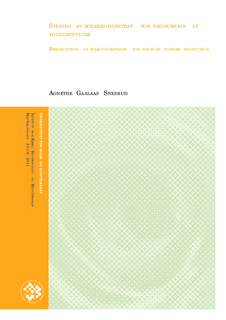| dc.description.abstract | In Norway, yoghurt powder is produced by TINE Meieriet Brumunddal (TMB). They produce about 70 tons powder per year, which is used as an ingredient for different products in the food industry. The yoghurt powder is produced by concentrating skim milk that is then inoculated with a yoghurt culture that ferments the concentrate to pH 4,80. The fermented concentrate is then spray dried. For a longer period, TMB has had problems with unstable fermenting process which has affected the quality of the yoghurt powder. In this study, the effect of dry matter in skim milk concentrate on the fermenting ability of two yoghurt cultures is examined. The effect that the different yoghurt cultures may have on the content of flavor compounds and the quality of the yoghurt powder was also examined. The fermenting ability of the yoghurt cultures F-DVS YC-471 Yo-Flex® (YC-471) and F-DVS YC-183 Yo-Flex® (YC-183) produced by Chr. Hansen was investigated in skim milk concentrate from TMB. In the experiments, it was prepared samples with a dry matter content of 20 %, 22,5 %, 24 %, 25 %, 26 %, 27 %, 28 %, 29 %, 30 %, 32,5 % and 35 %. The samples were inoculated with 0,02 % yoghurt culture , which is recommended by Chr. Hansen. In addition, three samples with respectively 24 %, 26 % and 28 % dry matter content was inoculated with 0,005 % yoghurt culture which is equal to the amount used in the yoghurt powder production in TMB. The samples were incubated at 43 °C until pH 4,80 was achieved. Through the fermentation experiment, the pH was measured every half hour for 9 hours and samples for microbiological analysis were taken out every hour for 6 hours. The fermented samples were analyzed by HPLC and HSGC to determine the contents of lactose, lactic acid, acetaldehyde, ethanol, acetone, diacetyl and acetoin. This study also examined the fermenting process of 10 yoghurt powder productions at TMB. The final yoghurt powders of the productions were analyzed to determine pH, density, dry matter, appearance, scent and flavor, scorched particles, fat content, growth of spoilage bacteria and chemical aroma components. The content of dry matter in the skim milk concentrate affected the fermenting ability of the yoghurt culture. The fermentation decreased when the content of dry matter increased. YC-183 contains a strain of Lactobacillus (Lb.) delbrueckii subsp. bulgaricus that appeared to be sensitive towards osmotic pressure and was not capable of growing in skim milk concentrate with a content of dry matter above 20 %. The strain of Lb. delbrueckii subsp. bulgaricus in YC-471 grew in skim milk concentrate with 20 % and 22,5 % dry matter. During 6 hours the number of lactobacilli grew to a number of 6,65 log kde/ml (in 20 % dry matter) and 6,11 log kde/ml (in 22,5 % dry matter). The strain of Streptococcus (S.) thermophilus in YC-471 was utterly inhibited when the content of dry matter exceeded 32,5 % and showed no growth in the sample containing 35 % dry matter. On the other hand, YC-183 contains a strain of S. thermophilus that grew in all the samples, including the one containing 35 % dry matter. The samples inoculated with 0,02 % yoghurt culture fermented more rapidly than the samples inoculated with 0,005 % yoghurt culture. The fermentation process seemed to affect lactic acid and acetaldehyde, scent and flavor, appearance and scorched particles in yoghurt powder. | |
